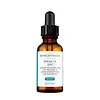What's inside
What's inside
 Key Ingredients
Key Ingredients

 Benefits
Benefits

 Concerns
Concerns

 Ingredients Side-by-side
Ingredients Side-by-side

Water
Skin Conditioning3-O-Ethyl Ascorbic Acid
Skin ConditioningPropylene Glycol
HumectantAlcohol Denat.
AntimicrobialGlycerin
HumectantPropanediol
SolventEthoxydiglycol
HumectantPentylene Glycol
Skin ConditioningDiglycerin
HumectantXylitylglucoside
HumectantAlgin
MaskingDisodium Phosphate
BufferingEvodia Rutaecarpa Fruit Extract
Skin ConditioningGlyceryl Polyacrylate
Methyl Diisopropyl Propionamide
MaskingPotassium Phosphate
BufferingPullulan
Serine
MaskingTrehalose
HumectantAnhydroxylitol
HumectantSodium Hyaluronate
HumectantUrea
BufferingXylitol
Humectant1,2-Hexanediol
Skin ConditioningCaprylyl Glycol
EmollientCitric Acid
BufferingHydroxyethylcellulose
Emulsion StabilisingSodium Citrate
BufferingParfum
MaskingWater, 3-O-Ethyl Ascorbic Acid, Propylene Glycol, Alcohol Denat., Glycerin, Propanediol, Ethoxydiglycol, Pentylene Glycol, Diglycerin, Xylitylglucoside, Algin, Disodium Phosphate, Evodia Rutaecarpa Fruit Extract, Glyceryl Polyacrylate, Methyl Diisopropyl Propionamide, Potassium Phosphate, Pullulan, Serine, Trehalose, Anhydroxylitol, Sodium Hyaluronate, Urea, Xylitol, 1,2-Hexanediol, Caprylyl Glycol, Citric Acid, Hydroxyethylcellulose, Sodium Citrate, Parfum
Ingredients Explained
These ingredients are found in both products.
Ingredients higher up in an ingredient list are typically present in a larger amount.
Ethoxydiglycol is a synthetic solvent.
Solvents are used to keep ingredients together in a product. They can help dissolve ingredients to stable bases or help evenly distribute ingredients throughout the product.
Ethoxydiglycol also helps deliver other key ingredients into the skin.
Learn more about EthoxydiglycolGlycerin is already naturally found in your skin. It helps moisturize and protect your skin.
A study from 2016 found glycerin to be more effective as a humectant than AHAs and hyaluronic acid.
As a humectant, it helps the skin stay hydrated by pulling moisture to your skin. The low molecular weight of glycerin allows it to pull moisture into the deeper layers of your skin.
Hydrated skin improves your skin barrier; Your skin barrier helps protect against irritants and bacteria.
Glycerin has also been found to have antimicrobial and antiviral properties. Due to these properties, glycerin is often used in wound and burn treatments.
In cosmetics, glycerin is usually derived from plants such as soybean or palm. However, it can also be sourced from animals, such as tallow or animal fat.
This ingredient is organic, colorless, odorless, and non-toxic.
Glycerin is the name for this ingredient in American English. British English uses Glycerol/Glycerine.
Learn more about GlycerinPropylene Glycol is an odorless, colorless liquid. As a humectant, it helps skin retain moisture. It also aids in delivering active ingredients.
Another role of this ingredient is preventing a product from melting or freezing. Propylene glycol also adds antimicrobrial properties to a product, elongating product lifespan.
This ingredient is considered an organic alcohol and commonly added into both cosmetics and foods.
Those with sensitive skin or conditions may develop a rash when using this ingredient.
Learn more about Propylene GlycolSodium Hyaluronate is hyaluronic acid's salt form. It is commonly derived from the sodium salt of hyaluronic acid.
Like hyaluronic acid, it is great at holding water and acts as a humectant. This makes it a great skin hydrating ingredient.
Sodium Hyaluronate is naturally occurring in our bodies and is mostly found in eye fluid and joints.
These are some other common types of Hyaluronic Acid:
Learn more about Sodium HyaluronateWater. It's the most common cosmetic ingredient of all. You'll usually see it at the top of ingredient lists, meaning that it makes up the largest part of the product.
So why is it so popular? Water most often acts as a solvent - this means that it helps dissolve other ingredients into the formulation.
You'll also recognize water as that liquid we all need to stay alive. If you see this, drink a glass of water. Stay hydrated!
Learn more about Water